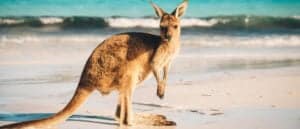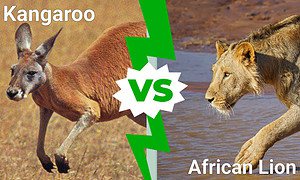Kangaroos are unique and fascinating Australian animals. They are best known for their distinctive hopping jump and tiny joey that they carry in a pouch on their front. Kangaroos are herbivores and are grazers and browsers. They travel for miles every day in search of grass, leaves, and shrubs. However, their teeth are also as unique and unusual as they are and are highly adapted for their diet. But how many teeth do they have and what is so special about them? Join us as we discover everything you need to know about kangaroo teeth!
Kangaroo Milk Teeth
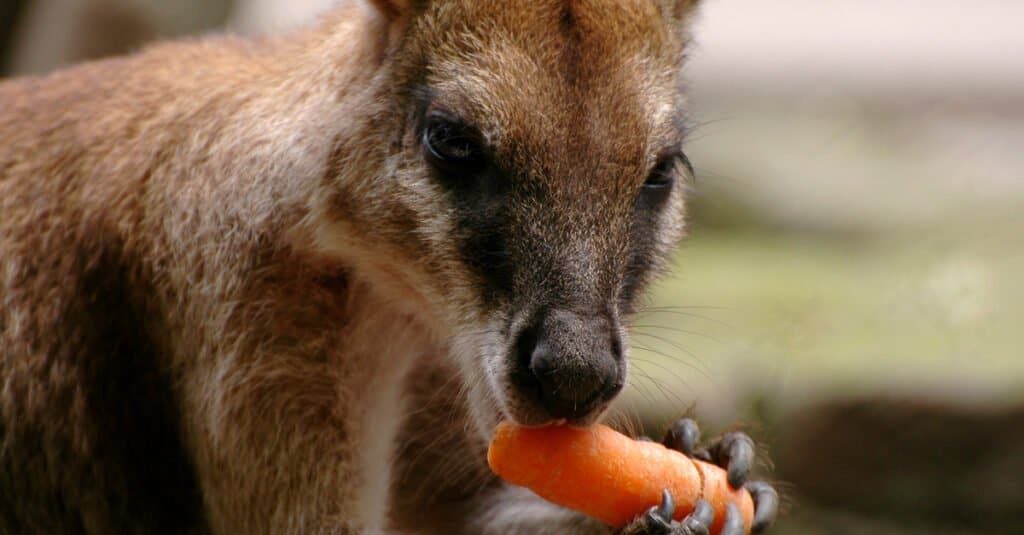
©Chaffelisnoir/Shutterstock.com
Prior to developing their complete set of adult teeth, kangaroos have some milk teeth – also known as deciduous teeth. However, kangaroos are unusual as they don’t have a complete set of milk teeth. Instead, the only deciduous teeth that they have are premolars. The incisors and molars of kangaroos only emerge as adult teeth.
Although kangaroos only have two adult premolars on each side they actually have three deciduous premolars. The first two pairs of deciduous premolars are often described as being “blade like” because of their their shape. These first two premolars are fully erupted by the time the kangaroo is one year old and are shed between the age of two and three. The first two premolars are then replaced by the third premolar which erupts soon after they have been shed.
All of the milk teeth are shed and the complete set of adult teeth are present by the time kangaroos are around 5 years old.
How many Teeth do Kangaroos have?
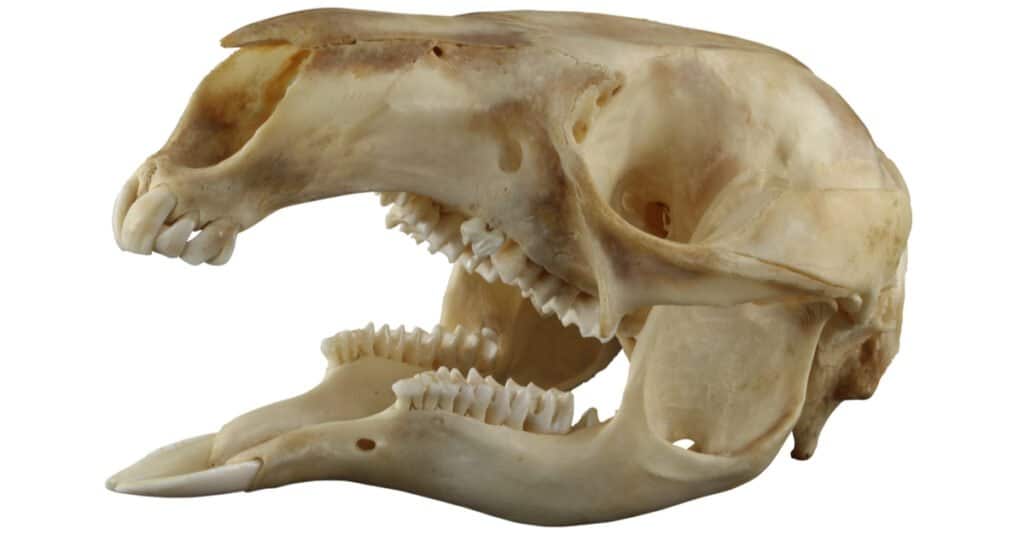
Kangaroos have 34 teeth, which include 8 incisors.
©Satirus/Shutterstock.com
Kangaroos have an extremely unique dental formation which is completely different to most other grazing animals. Most herbivores have teeth that grow almost continually throughout their lives, with more tooth coming down to be exposed as they wear it away. However, kangaroos teeth don’t work like that. Instead, they have four sets of cheek teeth on each side which move forward to replace the worn ones.
As fully developed adults kangaroos have 34 teeth which are made up of 8 incisors, 8 premolars, and 16 molars. As they are herbivores, kangaroos generally lack canine teeth, although sometimes they have one or two very small canines. Even if they have small canines there is still a significant gap between the front teeth (incisors) and cheek teeth (premolars and molars).
Incisors
Kangaroos have unique incisor teeth which have adapted to make pulling up tough or short blades of grass much easier. They have three pairs of incisors (6 teeth) on their upper jaw, and one pair on their lower jaw. Kangaroos lower incisors are larger than the rest of their teeth. The middle pair of incisors on their upper jaw are slightly larger than the rest of their upper incisors but still not as big as the lower ones. The middle pair correspond with the position of the lower incisors while the rest of their incisors are situated slightly further back and to each side of the middle pair. All of the incisors are usually fully erupted by the time the kangaroo is one year old.
The upper incisors have wide cutting edges and the way that they are positioned creates a continuous cutting edge. When kangaroos bite their lower incisors don’t actually meet their upper teeth. Instead, they press onto a tough pad on the roof of their mouth just behind the front pair of incisors on the top jaw. This creates a shearing action which can tear even the toughest grass or shrubs. However, the way that the lower incisors are positioned inside the arc of the upper incisors limits sideways motion. This means that kangaroos chew mostly with a forwards and backwards motion, with only a slight sideways action.
Premolars
Kangaroos have two adult premolars on each side on both their upper and lower jaws. These teeth have longitudinal (length-ways) cutting edges. In some species of kangaroo – such as the eastern grey – the first premolar is absent. This means that they only have one premolar on each side of both jaws.
Molars
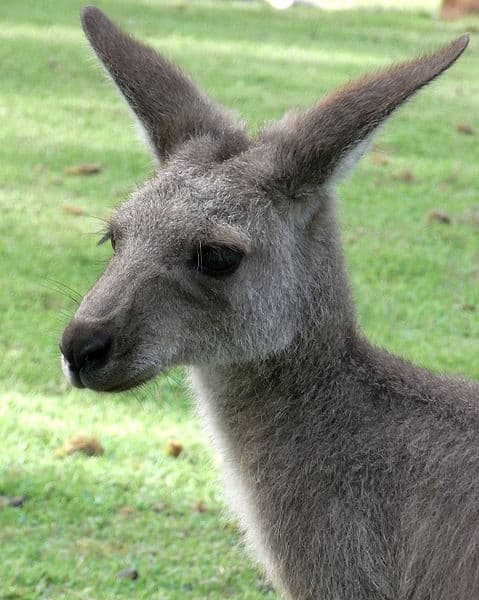
Kangaroos have unique cheek teeth which move forward to replace the old ones that drop out
Molars are the teeth that are situated the furthest back in the jaw, and kangaroos have four molars on each side of both upper and lower jaws. These teeth also have noticeable ridges on them to aid chewing. However, kangaroos actually only use the front two molars, with the last two being replacements. Unlike other herbivores, kangaroos wear their front molars down to the roots and they eventually drop out. As the front ones fall out, the molars from the rear of the jaw move forward to take their place. The first molars are generally shed around the age of seven.
By the time kangaroos reach old age (twelve to fifteen years old) they only have the last two molars remaining. Eventually these too are worn down to the roots and drop out. When this happens the kangaroo is unable to eat and unfortunately starves to death.
Ancient Kangaroos use to Eat Meat!
Although today’s kangaroos eat strictly a herbivorous diet, ancient kangaroos actually ate meat. The largest of these carnivorous macropods was Propleopus oscillans. Propleopus oscillans lived during the Pleistocene era and stood around 6 feet tall. Their teeth were adapted to their meat-eating diet and – like most other carnivores – had large canine teeth which are also known as fangs. These canine teeth were used for tearing into meat and are absent in modern kangaroos. These ancient kangaroos were larger than today’s modern kangaroo species.
However, possibly the most terrifying ancient kangaroo was Ekaltadeta. Ekaltadeta lived during the late Oligocene and Miocene periods (approximately 25-50 million years ago). Their name comes from an indigenous Australian language and means “powerful tooth”. A type of rat kangaroo, Ekaltadeta galloped rather than hopped and would have been an incredibly fearsome sight based on the skulls that have been found. They had enlarged teeth in their lower jaw which protruded forward and has earned them the nickname “killer kangaroo”. It is believed that they stabbed their prey with their long teeth and then held them with their front legs while they ate them. However, although they definitely ate meat, they’re actually believed to have been omnivorous as they lived in rainforests.
The photo featured at the top of this post is © iStock.com/slowmotiongli
Thank you for reading! Have some feedback for us? Contact the AZ Animals editorial team.




